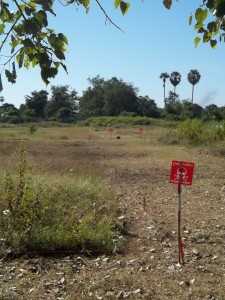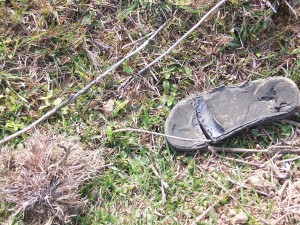
Until the 1990s, antipersonnel landmines had been used by most armed forces of the world, in one form or another, causing tens of thousands of casualties a year and creating many hardships for affected communities that could no longer safely access land, buildings, and natural resources.
The horrendous effect of landmines on communities throughout the world was witnessed by the founding member organizations of the ICBL, which joined forces in 1992 to address the problem. It soon became apparent that the only real solution to address the landmine crisis was a complete ban on antipersonnel mines. No technical changes or changes to the rules on their use could change the fact that an antipersonnel mine is inherently indiscriminate. Once planted it will never be able to tell the difference between a military and civilian footstep and will remain a threat to communities for decades to come.
The ICBL, in close partnership with a small number of states, the ICRC, and the UN, therefore put in motion what was later known as the “Ottawa Process” that led to the adoption of the Mine Ban Treaty in September 1997. The Mine Ban Treaty, which includes a comprehensive ban on all antipersonnel mines as well as several measures to redress the harm from past use, was adopted in Oslo (Norway) in September 1997, and opened for signature on 3 December 1997 in Ottawa (Canada.)
While numerous challenges remain, landmine use has dramatically dropped thanks to the Mine Ban Treaty, as has global production and trade. Additionally, tens of millions of antipersonnel mines have been destroyed, large areas of contaminated land have been cleared and returned to communities for safe use, and landmine victims’ rights and needs are receiving greater attention by affected states.
 In 1997, students in Morgantown, West Virginia started a school organization called PSALM (PROUD STUDENTS AGAINST LANDMINES). PSALM students were concerned about the devastation caused by these weapons and wanted to do something about it. PSALM students are, to this day, still working for a LANDMINE/CLUSTER BOMB FREE WORLD. Join us in bringing an end to the misery caused by these weapons!
In 1997, students in Morgantown, West Virginia started a school organization called PSALM (PROUD STUDENTS AGAINST LANDMINES). PSALM students were concerned about the devastation caused by these weapons and wanted to do something about it. PSALM students are, to this day, still working for a LANDMINE/CLUSTER BOMB FREE WORLD. Join us in bringing an end to the misery caused by these weapons!
Arguments for the Ban
There are dozens of reasons why all states should get on board the Mine Ban Treaty, and why full implementation of this lifesaving treaty must be ensured. Some of the moral, humanitarian, socio-economic and diplomatic arguments are given here.
The human costs
Antipersonnel landmines still maim and kill ordinary people every day. They blow off their victims’ legs, feet, toes and hands. They fire shrapnel into their faces and bodies. They kill.

Civilians bear the brunt
Because antipersonnel mines are indiscriminate and stay in or on the ground long after wars end, the vast majority of victims are civilians, not soldiers. Year after year, Landmine Monitor has reported that civilians account for 70 to 85 percent of casualties. This is not just during a conflict – most of the countries where casualties are reported are at peace.
Humanitarian law
Antipersonnel mines are indiscriminate and inhumane weapons and therefore violate the basic elements of international humanitarian law. The law of war imposes certain restrictions on how combatants operate. It says that they have to distinguish between civilian and military targets and that the injuries inflicted should be proportionate with military objectives. Antipersonnel landmines fail both the discrimination and the proportionality tests.
Landmines are indiscriminate because a landmine is triggered by its victim, whether military or civilian. Landmines are inhumane because, by design, they inflict brutal damage to the human body that kills or create life-long injuries.
Long-term effects
Once planted, landmines don’t go away until they are removed. Landmines sown during the First World War are still causing death and destruction in parts of Europe and North Africa. Landmines don’t obey peace agreements or ceasefires. The only way to prevent long-term damage is to stop any landmine use altogether and devote resources to clearing minefields and helping mine victims.
Lethal obstacles to economic growth
- Landmines slow repatriation of refugees and displaced people, or even prevent it altogether.
- They hamper the provision of aid and relief services and threaten, injure and kill aid workers.
- Medical treatment for landmine victims, where available, is costly, burdening an already overstretched health-care system.
- Communities are deprived of their land they depend upon: farm land, orchards, irrigation canals, forests, and water points may be no longer accessible.
- Mines also cut off access to economically important areas, such as roads, electricity pylons and dams.
- A landmine incident may cost a family their breadwinner.
- Vocational training and support are often not available so many survivors struggle to make a living after their accident.
- On the flipside, a mine-affected country stands to gain international assistance for mine clearance and victim assistance once it joins the Mine Ban Treaty. Donor governments are understandably reluctant to fund demining in countries that have not yet given up landmines altogether.
Children who are injured by landmines will face months of recovery… if they don’t die and if they get treated in time. Many are killed on the spot due to blood loss, shock or damage to vital organs. A growing child with a prosthetic limb will need it refitted each year. Some children never return to school after their accident. Many face social exclusion, for example, they are not seen as fit to marry. Like adult victims, they will face enormous practical, economic, social and psychological challenges in their rehabilitation and reintegration process.
Military arguments don’t hold up
The military arguments for using antipersonnel landmines are deeply flawed. The International Committee of the Red Cross’ 1996 study Antipersonnel Landmines – Friend or Foe? concluded that antipersonnel mines are not indispensable weapons, do not have high military value, and don’t necessarily offer any military advantage. In fact “their use in accordance with military doctrine is time-consuming, expensive and dangerous and has seldom occurred under combat conditions,” the group of military experts concluded.
Landmines are not needed by a modern army. While in the past they may have protected borders and slowed advancing troops, now most armies are mobile and can get through a minefield in less than 30 minutes. Modern motion detection equipment, night detection technology and strategically placed guns can protect military installations, borders and other areas better than landmines. Also, landmines injure and kill soldiers – the very people they are meant to protect. For example, in the 1991 Gulf War, landmines caused 34% of USA casualties.
In any case, the long-term humanitarian costs of mines far outweigh any limited military utility. This is why many former military personnel support a ban on antipersonnel mines and reject mine use, such as in this article by Lt. General Robert G. Gard Jr. (USA, Ret.), published in the Huffington Post in 2009. If a country’s military insists that antipersonnel landmines are still essential from a military point of view, suggest they look at the ICRC’s study mentioned above. Also, encourage them to do their own study to review their mine policy and its impact, including on their own soldiers.
The ban works!
Banning landmines makes a difference. We have made a great deal of progress since the Mine Ban Treaty came into force in March 1999. The global stigma attached to these weapons has led to a virtual halt in the global trade in antipersonnel mines, a sharp drop in the number of producers and a drastic reduction in the number of governments laying mines, even among states that still refuse to officially join the treaty. Vast tracts of land have been cleared and put back into productive use; there has been widespread and extensive destruction of stockpiled mines; the rights and needs of landmine victims have gained greater recognition; and most importantly, there are now fewer new mine victims each year.
Peace and security
Banning landmines increases peace and security and can be a valuable peace-building tool. For example, Greece and Turkey, long-term rivals with border disputes, used their shared commitment to joining the Mine Ban Treaty as a confidence building measure. Some states have joined the Mine Ban Treaty despite ongoing internal conflict, such as Afghanistan, Colombia and the Democratic Republic of Congo. Some states, like Cyprus, joined the treaty even though they do not have full control over the area they say falls under their jurisdiction.
Border protection: there are alternatives
Mines are largely ineffective in protecting border regions, for example from smugglers, illegal immigrants or non-state armed groups. Ask your target government to provide information on whether and how landmines have been an effective deterrent for a specific stated purpose (e.g. to stop smuggling). Usually governments cannot prove effectiveness. Instead of offering protection, minefields terrorize and impoverish the communities living in the area. Alternatives exist and include: engaging in dialogue with a neighbor, mobile and fixed border patrol and motion detection equipment and barriers.
Everyone’s support is needed along the road to a mine-free world — no matter whether the country is mine-affected or not or whether it is large or small. Joining the Mine Ban Treaty is in the interest of mine-affected countries because it will spur international support for their landmine problem. For countries with no mines in stockpiles or in the ground, joining the Mine Ban Treaty is also in their interest as they will gain a higher moral standing within the diplomatic world and will demonstrate their support for affected communities worldwide.
All governments should listen to their citizens and the international community who demand that they take a stand, otherwise they risk becoming moral outcasts. Even interim steps that fall short of joining the Mine Ban Treaty are valuable, such as a moratorium on the use and transfer of antipersonnel mines, the provision of information on landmine stockpiles and their destruction, or voting in favor of the annual United Nations’ General Assembly resolution on the treaty.



